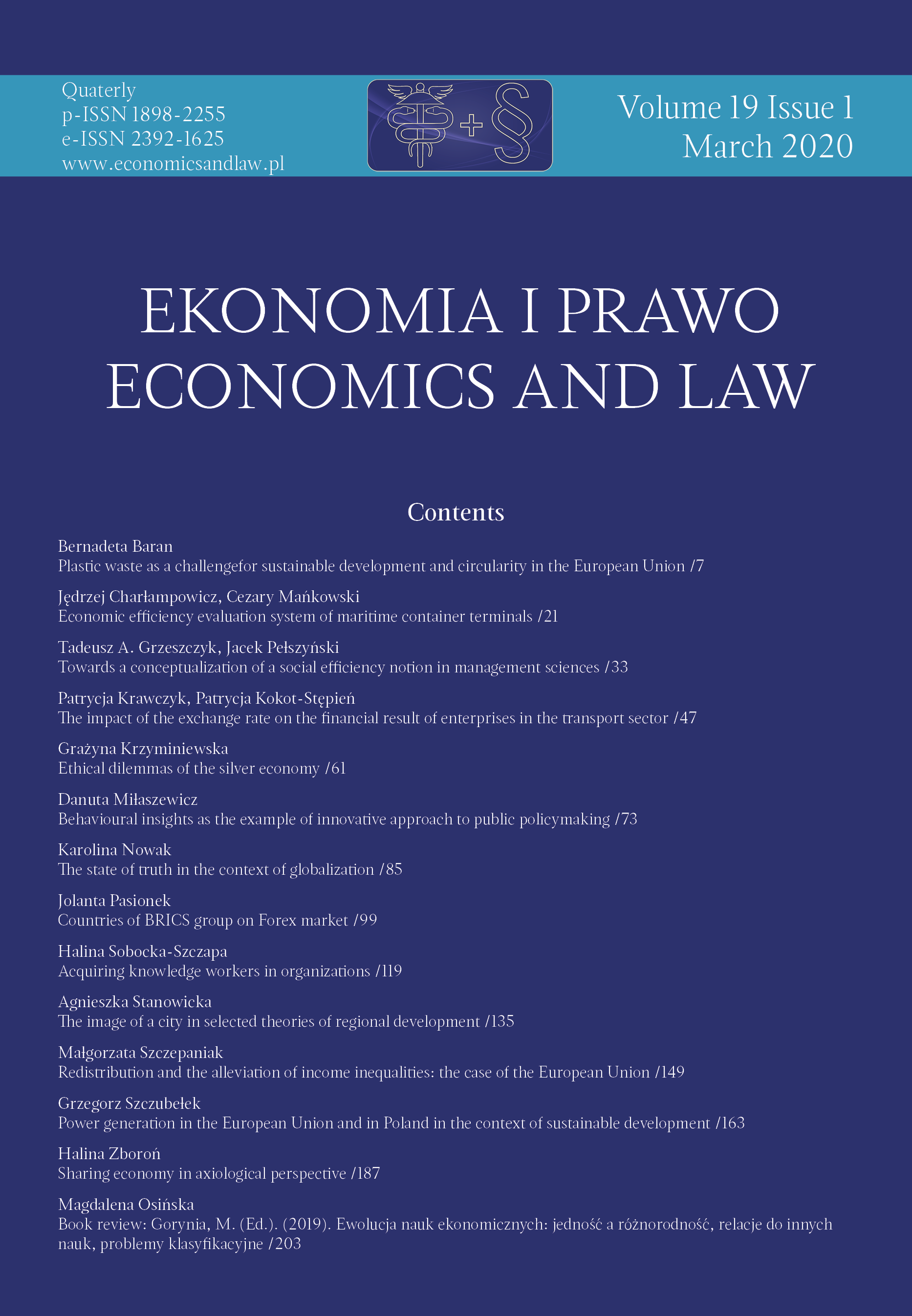Countries of BRICS group on Forex market
DOI:
https://doi.org/10.12775/EiP.2020.008Keywords
foreign exchange market, transaction instruments, BRICS countries, emerging marketsAbstract
Motivation: The globalization process has deepened the links between economies in the global socio-economic system. It has resulted in the shift of economic power from high developed countries to economies that have entered the path of fast socio-economic development, especially emerging markets. The emerging economies’ dynamic economic growth empowers the reduction of the development gap in relation to high developed economies. In the context of emerging markets, the special importance is dedicated to so-called BRICS countries. The share of BRICS countries in total world production as well as in total global trade, increases. The huge population and the GDP growth per capita make these economies the important markets nowadays. The financial market, especially the foreign exchange market becomes more and more important in the world economy.
Aim: The aim of the paper is to examine the participation of the BRICS countries in the global foreign exchange market. The paper assumes that the increase of the BRICS group importance on the global markets does not correspond with the increase in the importance of these economies currencies on the Forex market. The BRICS group’s turnover in global foreign exchange turnover will be examined. In addition, the share of these currencies in the segments of particular types of transactions will be examined.
Results: The importance of the BRICS group in the global economy is growing. However, this growth is not accompanied by growth of interest in currencies of this group on Forex market. The share of transactions concluded with the use of currencies of BRICS group was only 5% in 2019. Whereas, total currency turnover of the BRICS group countries was only 3% in 2019. The share of BRICS countries in individual market segments can be considered stable, yet insignificant.
References
Asian Development Bank. (2011). Asia 2050: realizing the Asian century. Retrieved 30.03.2019 from http://www.iopsweb.org.
Bhattacharya, S.N., Bhattacharya, M., & Roychoudhury, B. (2017). Behaviour of the foreign exchange rates of BRICS: is it chaotic? The Journal of Prediction Markets, 11(2). doi:10.5750/jpm.v11i2.1247.
Bieliński, T. (2013). Kurs walutowy i międzynarodowy rynek walutowy. In E. Oziewicz, & T. Michałowski (Eds.), Międzynarodowe stosunki gospodarcze. Warszawa: PWE.
BIS. (2001). Foreign exchange and derivatives market activity in 2001. Retrieved 30.04.2018 from https://www.bis.org.
BIS. (2007). Foreign exchange and derivatives market activity in 2007. Retrieved 05.01.2020 from https://www.bis.org.
BIS. (2013). Foreign exchange turnover in April 2013. Retrieved 30.04.2018 from https://www.bis.org.
BIS. (2016). Foreign exchange turnover in April 2016. Retrieved 30.04.2018 from https://www.bis.org.
BIS. (2019). Foreign exchange turnover in April 2019. Retrieved 05.01.2020 from https://www.bis.org.
Caporale, G.M.F., Spagnolo, F., & Spagnolo, N. (2016). Macro news and exchange rates in the BRICS. Finance Research Letters, 21. doi:10.1016/j.frl.2016.12.002.
Dadush, U., & Shaw, W. (2011). Juggernaut: how emerging markets are reshaping globalization. Washington: Carnegie Endowment for International Peace.
IMF. (2019). Retrieved 10.01.2020 from https://www.imf.org.
Jagadeesan, R., & Swanson, P.E. (2018). Linkages of BRIC countries: Brazil, Russia, India and China and the USA. Journal of Emerging Market Finance, 17(3). doi:10.1177/0972652718800081.
Klecha, K. (2006). Współczesny międzynarodowy system walutowy. In E. Oziewicz (Ed.). Przemiany we współczesnej gospodarce światowej. Warszawa: PWE.
Knapińska, M. (2016). Rozwój gospodarczy w podstawowych miernikach makroekonomicznych. Zeszyty Naukowe Polskiego Towarzystwa Ekonomicznego w Zielonej Górze, 4.
Kubiczek, A. (2014). Jak mierzyć dziś rozwój społeczno-gospodarczy krajów? Nierówności społeczne a wzrost gospodarczy, 38(2).
Liberska, B. (2010). Perspektywy rozwojowe chińskiej gospodarki do 2050 roku. Studia ekonomiczne: Polska Akademia Nauk Instytut Nauk Ekonomicznych, 4(67).
Liberska, B. (2013). Nowe centra wzrostu światowej gospodarki. Studia ekonomiczne: Polska Akademia Nauk Instytut Nauk Ekonomicznych. 2(77).
Markiewicz, M., & Szmelter, M. (2015). Charakterystyka rynku walutowego wybranych walut azjatyckich. Studia i Prace Wydziału Nauk Ekonomicznych i Zarządzania Uniwersytetu Szczecińskiego, 41(2).
Markiewicz, M., & Szmelter, M. (2016). Rola regionu Azji i Pacyfiku na światowym rynku walutowym. Zeszyty Naukowe Uniwersytetu Szczecińskiego: Finanse Rynki Finansowe Ubezpieczenia, 3. doi:10.18276/frfu.2016.81-14.
O’Neill, J. (2001). Building better global economic BRICs. Goldman Sachs Global Economics Paper, 66.
Parysek, J.J. (2018). Rozwój społeczno-gospodarczy oraz czynniki i uwarunkowania rozwoju. Studia: Polska Akademia Nauk Komitet Przestrzennego Zagospodarowania, 183.
Rubaszek, M. (2009). Modele kursu równowagi. In W. Marcinkowska-Lewandowska (Ed.), Analiza kursu walutowego. Warszawa: C.H. Beck.
Siudek, T., & Drabarczyk, K. (2015). Wzrost i rozwój gospodarczy a efektywność finansowa banków komercyjnych w krajach Unii Europejskiej. Zeszyty Naukowe SGGW w Warszawie: Problemy Rolnictwa Światowego, 15(30).
Świerkocki, J. (2011). Zarys ekonomii międzynarodowej. Warszawa: PWE.
World Bank. (2019). Retrieved 10.01.2020 from https://data.worldbank.org.
Zielińska-Głębocka, A. (2012). Współczesna gospodarka światowa: przemiany, innowacje, kryzysy, rozwiązania regionalne. Warszawa: Oficyna Wolters Kluwers Business.
Downloads
Published
How to Cite
Issue
Section
Stats
Number of views and downloads: 671
Number of citations: 0
